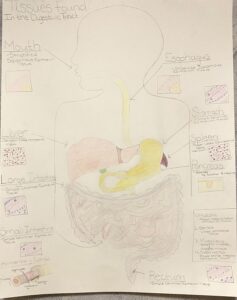For my project, I decided to draw a diagram of the upper region of the human body and draw the main organs involved in the digestive tract. My STEAM project is about the different types of tissues that are found in the digestive tract that help with our everyday digestion. To show what types of tissues are found in each part of our digestive tract, I drew the specific tissue, that we learned about this semester, of which is found within the organ. I decided to draw the tissues magnified, such as we did with our tissue booklets, to show the different components that are found in each type of tissue.


This paper is about the different types of tissue in the digestive tract, and how their design is relative to the specific jobs they perform. A&P is about the structure and function of the human body. Samantha presented well thought-out examples in her paper. For instance, the tissue of the mouth and esophagus is multilayered, stratified squamous epithelial tissue. High-traffic areas need cheap and easily replaceable cells, due to fast turn-over. The epithelium of the stomach is made of simple columnar tissue, with microvilli, cilia and goblet cells, which secret enzymes, hormones and mucus to protect us from bacteria, like Salmonella. The more inflammation that exist in our guts, the less able it is to protect us from foreign invaders, like Salmonella. It is evident that if we take care of our gut, it will take better care of us.
The muscularis of the small intestines is made of smooth muscle tissue, which helps push partially digested food through our guts. Another muscularis tissue is made of skeletal muscle. It is located in our mouths and esophagus, and aids in swallowing. Another example of form following function.
I have never seen a diagram or illustration like Samantha’s, based on the types of tissue specific to the corresponding anatomy. I think it is a brilliant way to make sense of tissues and systems. Especially with the accompanying tissue illustrations. Samantha’s paper was well researched and thoughtfully constructed. It made me aware of how important form is to function in biology
Your essay was very informative throughout most of the paper about the parts of the digestive system and the tissues throughout. It was very packed with information about what you had learned throughout the semester, and your opinion on those such topics. It was interesting to refresh on all of this information as I read. I was able to remember a lot of this information that you presented. I could then put it into context with other parts of your paper and I was able to follow where you were going. Your essay also explained a bunch of different ways how you were interested in the material. Your paper thoroughly showed us that you did indeed care about the information you wrote on and this project. The paper did this by using exclamations of wonder and awe as well as by being so deep and detailed on each tissue and their function. After identifying each tissue, and then describing them, you were able to go into great detail of their function and area of production in the body. This brought the previous limbs of information into a complete body. This was by expanding on the tissues from previous, and highlighting how the body benefits. You summed up all of this knowledge well in the end, and were able to explain your project piece well. For your last paragraph, you told us how you constructed your drawing of the information given about the digestive system, its specific tissues and made sure we knew how your drawing was put together and how to read it.